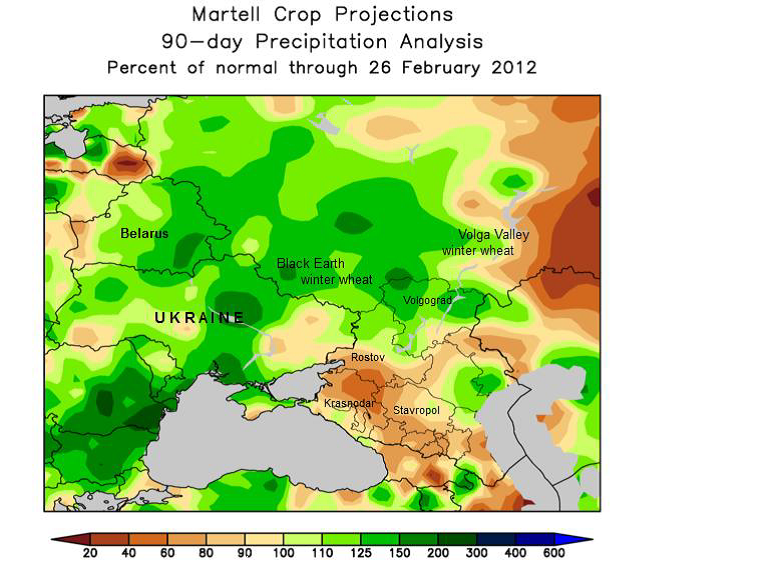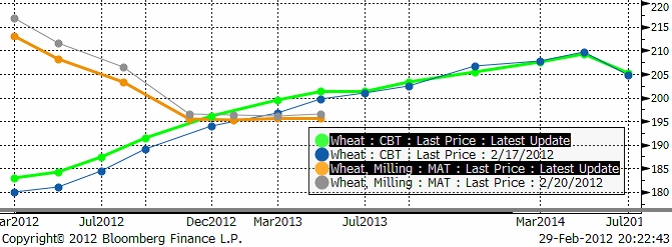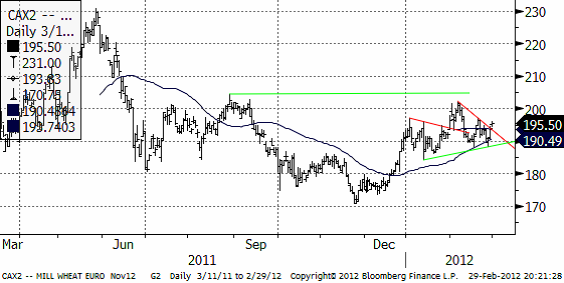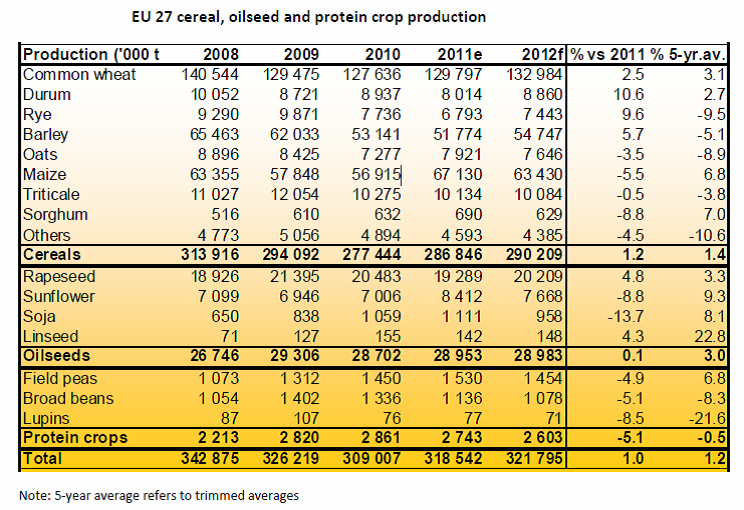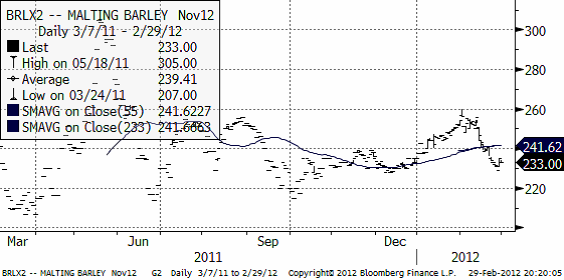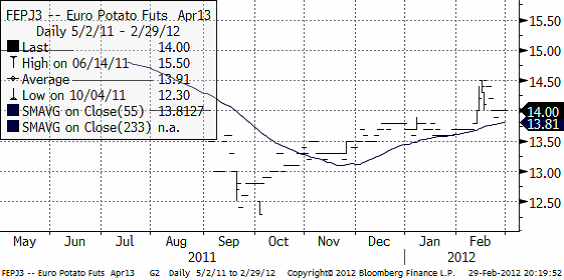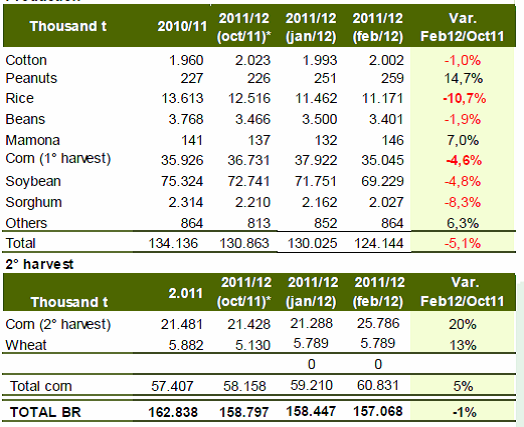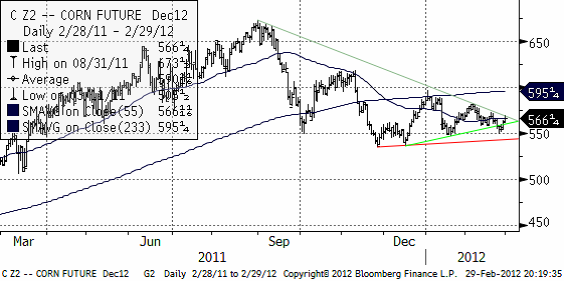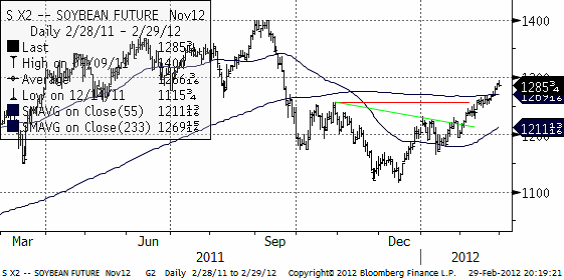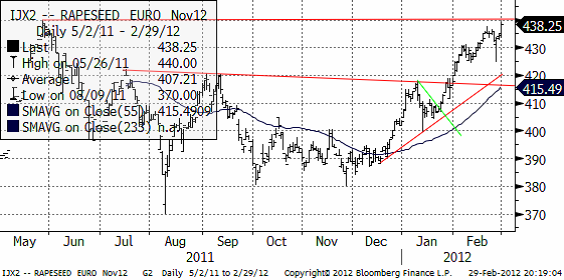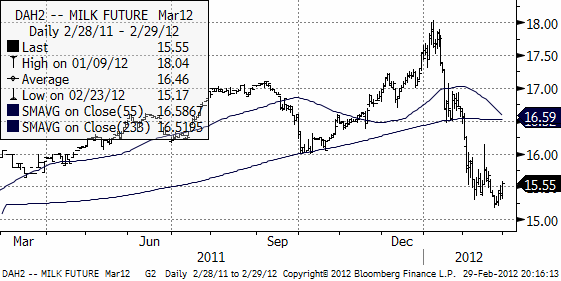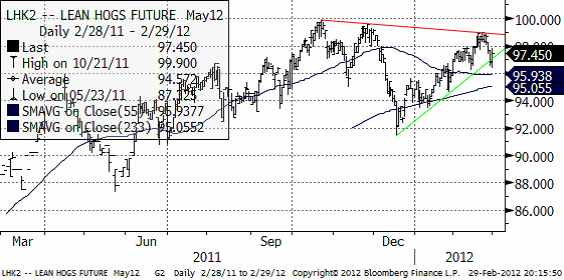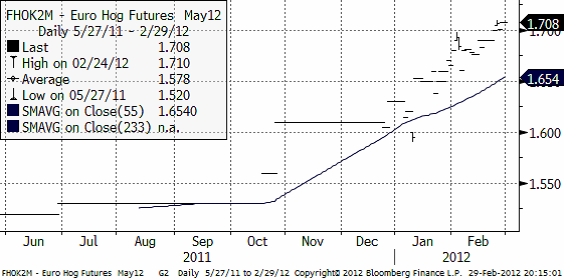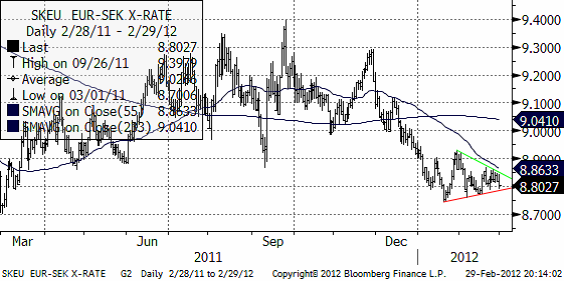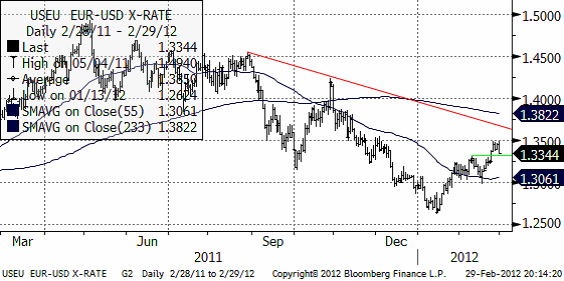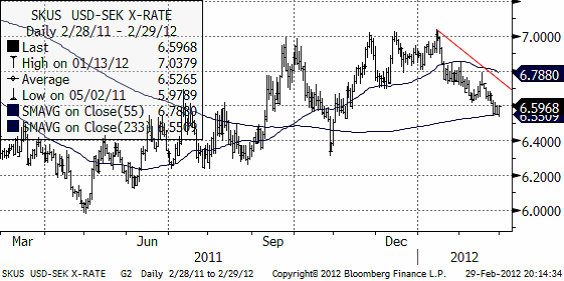Analys
SEB – Jordbruksprodukter, vecka 9 2012
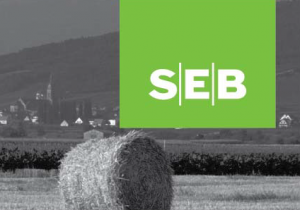 Inledning
Inledning
Den senaste veckan har prisförändringarna varit små. Ett par rörelser sticker ut och det är en prisuppgång på sojamjöl på uppemot 6% och en prisuppgång på Chicagovete med 3%. Intressant är att Chicagovetet stigit och Matifvetet fallit, när man räknar om båda till samma valuta. Av största vikt just nu är utsikterna för vädret under vår och sommar på norra halvklotet och storleken för skördebortfallet i Sydamerika. Vi går igenom detta i tur och ordning i det här brevet.
Vi måste också nämna Benny från FEDs mycket stramare finanspolitik. Den amerikanska centralbanken FED:s chef Ben Bernanke gav ett tal till Representanthuset idag, som hade stor påverkan på marknaden. Silverpriset föll som mest med 10% efteråt. Huvudbudskapet var att den amerikanska ekonomin tuffar på i oförändrad takt om 2.5% tillväxt på årsbasis. Han kommenterade finanspolitik och oljepris, men det var hans kommentarer om penningpolitiken som fick marknaden att skaka till. Han plockade inte upp stafettpinnen från ECB – som just nu fullkomligen sprutar ut friska pengar i euroland, 4300 miljarder kronor idag. Benny gav ingen indikation alls som skulle kunna tyda på ett nytt amerikanskt stimulanspaket, ett ”QE3” skulle kunna vara aktuellt. Detta fick guldpriset på fall och silverpriset tog i vanlig ordning ut svängen ännu mer. Basmetaller tyngdes också, däremot gick jordbruksprodukterna opåverkade ur dagen.
Väder
De senaste två veckorna har Southern Oscillation Index (“SOI”) fallit kraftigt och indikerar nu normala ENSO-förhållanden – alltså inget La Niña längre. Den senaste indexnoteringen, från den 26 februari ligger på +0.7. Ett värde > +8 innebär La Niña.
USA är som bekant torkdrabbat på grund av La Niña. Nedan ser vi ”US Drought Monitor”. Om det är någon gröda som råkat värst ut, så är det bomull. Det är rött både i det som kallas för ”Prairie Gateway” (västra Texas och uppåt) och ”Southern Seaboard” (norr om Florida).
Sydamerikas väderleksprognos visar idag nära normal nederbörd i norra Argentina, Paraguay och södra Brasilien. Södra Argentina och centrala och norra Brasilien är torrare. I Sao Paulo är det smällhett och det har inte regnat på länge. Karnevalen slutade i lördags. Nedan ser vi två satellitbilder på nederbörden över södra Brasilien och norra Argentina för tiodagarsperioden 11 februari och 20 februari. Till vänster ser vi nederbörden och till höger avvikelse från normal nederbörd.
Södra Europa är mycket torrt, medan norra Europa som bekant är fuktigt. Storbritannien deklarerade tidigare i veckan ett område i södra landsänden som ”torkdrabbat”.
Från Ryssland och Ukraina har det kommit motstridiga uppgifter. Martell, som gör väderleksprognoser för lantbruket, skrev den 28 februari att snötäcket över huvuddelen av vinterveteområdena har varit tillräckliga och att vetet bör ha klarat sig bra trots extrem kyla. Nedan ser vi en bild på snödjupet (i tum).
Nederbörden har enligt Martell varit god, som vi ser i nedanstående bild.
Det ryska jordbruksdepartementet väntar sig nu högre spannmålsexport för 2011/12 och siktar nu på 27 – 28 mt, mot tidigare 25 mt. Detta baserar sig sannolikt på en mer optimistisk bild av snötäcke och nederbörd. Detta är ett helt annat budskap än den oro för ett exportstopp per idag, 1 mars, som tidigare skrämde spannmålsmarknaden i världen.
Vädersituationen är alltså betydligt ljusare idag än den var för bara några veckor sedan, men mycket kan hända fram till skörd, förstås.
Vete
Vi börjar med att titta på hur terminspriskurvorna har förändrats de senaste 7 arbetsdagarna, där vi kan konstatera att den irrationella backwardation som finns i det europeiska kvarnvetet på Matif har minskat. Korta terminskontrakt har sjunkit mer än de med längre löptid. Sannolikt är det bönder i EU som börjat sälja från sina lager. Samtidigt har contangot i Chicagovetet minskat för där har korta terminskontrakt stigit mer än de med längre löptid. Vi förväntar oss att säljtrycket från europeiska bönder kommer att fortsätta och att backwardation kommer att fortsätta minska.
Prisnivån för t ex novemberleverans på Matif har inte förändrats så mycket. Nedan ser vi kursdiagrammet för detta:
En kort teknisk kommentar till diagrammet ovan: Å ena sidan har uppgången från december förlorat momentum och man skulle kunna tolka kursrörelserna hittills i år som en vändningsformation innan en förestående nedgång. Å andra sidan är det mycket kortsiktiga motståndet (röd linje) bruten på uppsidan. Skulle vi få en uppgång torde 200 euro återigen vara ett ställe där många gärna vill sälja, ett naturligt motstånd. Det är en lite svårläst marknad, men vi fortsätter att vilja sälja novemberkontraktet utifrån ett tekniskt perspektiv.
 IGC:s (International Grains Council) uppskattning av den globala veteproduktionen under 2011/12 har justerats upp med ytterligare 5 mt, jämfört med januari-rapporten, till rekordhöga 695 mt (ca 2 mt högre än USDA:s senaste prognos) vilket delvis återspeglar högre estimat för Kazakstan, Indien och Australien. Prognosen för globala utgående lager för vete 2011/12 justeras upp med 7 miljoner ton till 211 mt, en ökning med 8% jämfört med 196 mt 2011.
IGC:s (International Grains Council) uppskattning av den globala veteproduktionen under 2011/12 har justerats upp med ytterligare 5 mt, jämfört med januari-rapporten, till rekordhöga 695 mt (ca 2 mt högre än USDA:s senaste prognos) vilket delvis återspeglar högre estimat för Kazakstan, Indien och Australien. Prognosen för globala utgående lager för vete 2011/12 justeras upp med 7 miljoner ton till 211 mt, en ökning med 8% jämfört med 196 mt 2011.
Inför det kommande skördeåret 2012/13 förväntas den globala vete arealen öka med 1.5% och medan grödorna har utvecklats relativt väl på norra halvklotet, finns en fortsatt oro över hur torkan kommer att påverka delar av Ukraina och USA. Den genomsnittliga avkastningen kommer troligtvis inte att matcha föregående års höga siffror och den globala produktionen beräknas därför minska med 15 mt till 680 mt.
Från höga lager av vete och en ökning i produktionen av majs och korn i år (vilket sannolikt kommer att minska användningen av fodervete) förväntas endast en blygsam nedgång i utgående lager för 2012/13 jämfört med de förväntade rekordnivåerna den här säsongen.
Europeiska kommissionen skriver i sin prognos att höstsådden under 2011 inför årets skörd har ökat i de flesta länderna, med undantag för Sverige och Danmark där dåliga väderförhållanden påverkade sådden.
Oro finns också att den köldperiod som drabbade Europa i slutet av januari kan komma att påverka grödorna i delar av Väst och Östeuropa. En annan väderrelaterad oro är bristen på nederbörd i vissa delar av Portugal och Spanien, som vi nämnt ovan.
Kommissionen uppskattar att årets veteskörd kommer att uppgå till strax under 133 mt, vilket är en ökning med ca 3.2 mt jämfört med 2011 och bygger på en förväntad avkastning om 5.7 ton per hektar, vilket skulle vara högre än genomsnittet och det bästa resultatet på fyra år, trots en eventuell påverkan av köldknäppen tidigare den här månaden. En ökad sådd areal om 133 000 hektar borde också göra sitt till och den totala arealen för vete förväntas uppgå till 23.3 m hektar, vilket är mer än de estimerade 23.0 m hektar från den franska analysfirman Strategie Grains för två veckor sedan.
Ökad produktion och minskad konsumtion kommer att öka Europas utgående lager av vete i slutet av 2012/13 till 15.1 mt, enligt kommissionen. Användandet av vete som foderingrediens och efterfrågan på vete från etanolanläggningar förväntas minska.
Från Kina har kommit prognoser på en 46 mt lägre spannmålsskörd jämfört med förra årets rekord på 571 mt. Det har också talats om att använda vete som foder där. Kina är ett observandum, men annars bör det bli en press nedåt på vetepriset i världen framöver.
Maltkorn
Novemberkontraktet på maltkorn har handlats ner 1.25 euro sedan förra veckans brev. Vi finner inga specifika nyheter.
Potatis
Priset på industripotatis för leverans nästa år är oförändrat. För leverans i år har priset handlats ner ungefär 5%, dvs mer av samma sak som präglat marknadsföringsåret hela tiden.
Majs
Brasilien är nu i full fart med Safrinha, den andra skörden, som enligt Conabs senaste prognos väntas bli 25.8 mt istället för 21.3 mt, som man trodde i januariprognosen. Det kompenserar mer än väl bortfallet av den första skörden, som skadades av torka.
Nedan ser vi decemberkontraktet på majs på CBOT, där priserna bildat en klassisk ”triangelformation”. Vi skrev om detta redan förra veckan, men något utbrott har ännu inte inträffat – bortsett från ett falskt utbrott på nedsidan. Ett falskt utbrott brukar följas av en ordentlig rörelse åt andra hållet. Det återstår att se, men ett brott uppåt måste tas på allvar. Vi får ha en neutral rekommendation för tillfället.
Sojabönor
Det kortaste terminskontraket på CBOT stängde över 13 dollar för första gången på fem månader igår. Privata analysfirmor fortsätter att prognosticera Sydamerikas skörd 14 mt lägre än förra året. Novemberterminen närmar sig också 13 dollar, som vi ser i diagrammet nedan. Motståndet från toppen i oktober är passerad, men priset har kommit upp i det intervall som priset låg i för ett år sedan och som hade sin topp på 14 dollar. 13 dollar är ändå sannolikt en naturlig nivå där det troligtvis finns säljare som väntar.
Vi skulle vilja sälja november på den här nivån vid 13 dollar per bushel.
Raps
Novemberkontraktet föll kraftigt efter det förra veckobrevet, men återhämtade sig med ännu större kraft. Priset ligger nu bara 1.75 euro från 440. Det är en nivå där vi absolut skulle vilja sälja.
Trots att sådden av kanadensisk canola inte startar förrän i mitten av april har prognoser över arealen redan börjat komma med variationer mellan 7.85 m hektar till 8.49 m hektar. Om dessa siffror stämmer skulle det vara klart över 2011 års areal på 7.54 m hektar. Prognoser från Wild Oats Grainworld konferensen i Winnipeg uppskattar att canola kan komma att bli årets stora vinnare då estimat visar att för första gången någonsin kommer sådd areal för canola att överstiga sådd areal för vete (exkl durum) Skörden av canola blev större än skörden av vete förra året men det berodde på det stora bortfallet av vete på grund av de omfattande översvämningarna, särskilt i södra Manitoba. I år blir det absolut inte några översvämningar.
Den Europeiska kommissionen uppskattar EU-27’s produktion av raps till 20,2 mt för 2012, en ökning från det estimerade 19,1 mt under 2011. Trots en ökad produktion i år förväntas utgående lager bli låga, runt 1 mt, vilket understryker behovet för Europa att fortsätta importera raps.
Prognoserna för både Kanada och Europa är dock väldigt preliminära i detta tidiga skede och beror i mångt och mycket på förhållandena vid vårsådden samt väder under växtperioden.
Efter två bra säsonger för australiensisk canola tror AOF att även detta år kommer att bli bra. Produktionen för 2011 beräknas till 3 mt, men skulle kunna uppgå till så mycket som 3.3 mt. Den slutliga siffran kommer dock inte att presenteras förrän nästa månad. När det gäller canola behöver lantbrukaren bestämma sig runt april om det är den grödan som ska sås och vid den tiden förra året var priset på oljeväxter attraktiva i jämförelse med priset på vete vilket ledde till att en större areal än vanligt såddes med canola, 1.8 m hektar jämfört med 1.6 m hektar året innan.
Mjölk
För en vecka sedan låg priset på 15.37. Det blev en liten sväng nedåt, men sedan vände priset upp till 15.55 senast. Liksom vi skrev för en vecka sedan, tyder det mesta på att prisfallet är över. Det bör vara möjligt för marknaden att hämta tillbaka lite av fallet. Vid 16 ser vi att folk i oktober i alla fall, tyckte att 16 var en viktig nivå. På uppsidan kan vi nog därför gissa att en del kommer att reagera med säljordrar.
Gris
Majkontraktet orkade inte igenom motståndet (röd linje) utan föll av. Priset har nu också brutit den uppåtgående stödlinjen (grön) och det signalerar ett kortsiktigt trendbrott nedåt. Vi är negativa till priset på Lean Hogs. Priset i Europa har för majleverans stigit från 1.69 till 1.708 euro per kilo den senaste veckan.
Valutor
EURSEK
Läget är oförändrat från förra veckan: En ”triangelformation” har bildats sedan mitten av januari. Man bör invänta riktningen på utbrottet från den för att fatta beslut om att köpa eller sälja eursek. 8.70 har tidigare varit ett starkt ”golv” för växelkursen.
EURUSD
Euron steg mot dollarn, men efter ECB:s pengatryckeri och Ben Bernankes återhållsamhet föll euron idag, dock inte signifikativt ur ett tekniskt perspektiv.
USDSEK
Dollarn ligger för närvarande i sjunkande trend, men är nere på en nivå där det tidigare funnits stöd.
[box]SEB Veckobrev Jordbruksprodukter är producerat av SEB Merchant Banking och publiceras i samarbete och med tillstånd på Råvarumarknaden.se[/box]
Disclaimer
The information in this document has been compiled by SEB Merchant Banking, a division within Skandinaviska Enskilda Banken AB (publ) (“SEB”).
Opinions contained in this report represent the bank’s present opinion only and are subject to change without notice. All information contained in this report has been compiled in good faith from sources believed to be reliable. However, no representation or warranty, expressed or implied, is made with respect to the completeness or accuracy of its contents and the information is not to be relied upon as authoritative. Anyone considering taking actions based upon the content of this document is urged to base his or her investment decisions upon such investigations as he or she deems necessary. This document is being provided as information only, and no specific actions are being solicited as a result of it; to the extent permitted by law, no liability whatsoever is accepted for any direct or consequential loss arising from use of this document or its contents.
About SEB
SEB is a public company incorporated in Stockholm, Sweden, with limited liability. It is a participant at major Nordic and other European Regulated Markets and Multilateral Trading Facilities (as well as some non-European equivalent markets) for trading in financial instruments, such as markets operated by NASDAQ OMX, NYSE Euronext, London Stock Exchange, Deutsche Börse, Swiss Exchanges, Turquoise and Chi-X. SEB is authorized and regulated by Finansinspektionen in Sweden; it is authorized and subject to limited regulation by the Financial Services Authority for the conduct of designated investment business in the UK, and is subject to the provisions of relevant regulators in all other jurisdictions where SEB conducts operations. SEB Merchant Banking. All rights reserved.
Analys
Tightening fundamentals – bullish inventories from DOE

The latest weekly report from the US DOE showed a substantial drawdown across key petroleum categories, adding more upside potential to the fundamental picture.

Commercial crude inventories (excl. SPR) fell by 5.8 million barrels, bringing total inventories down to 415.1 million barrels. Now sitting 11% below the five-year seasonal norm and placed in the lowest 2015-2022 range (see picture below).
Product inventories also tightened further last week. Gasoline inventories declined by 2.1 million barrels, with reductions seen in both finished gasoline and blending components. Current gasoline levels are about 3% below the five-year average for this time of year.
Among products, the most notable move came in diesel, where inventories dropped by almost 4.1 million barrels, deepening the deficit to around 20% below seasonal norms – continuing to underscore the persistent supply tightness in diesel markets.
The only area of inventory growth was in propane/propylene, which posted a significant 5.1-million-barrel build and now stands 9% above the five-year average.
Total commercial petroleum inventories (crude plus refined products) declined by 4.2 million barrels on the week, reinforcing the overall tightening of US crude and products.
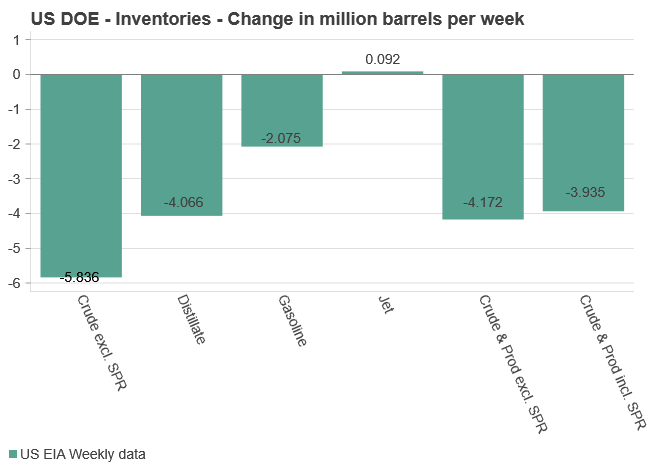

Analys
Bombs to ”ceasefire” in hours – Brent below $70

A classic case of “buy the rumor, sell the news” played out in oil markets, as Brent crude has dropped sharply – down nearly USD 10 per barrel since yesterday evening – following Iran’s retaliatory strike on a U.S. air base in Qatar. The immediate reaction was: “That was it?” The strike followed a carefully calibrated, non-escalatory playbook, avoiding direct threats to energy infrastructure or disruption of shipping through the Strait of Hormuz – thus calming worst-case fears.

After Monday morning’s sharp spike to USD 81.4 per barrel, triggered by the U.S. bombing of Iranian nuclear facilities, oil prices drifted sideways in anticipation of a potential Iranian response. That response came with advance warning and caused limited physical damage. Early this morning, both the U.S. President and Iranian state media announced a ceasefire, effectively placing a lid on the immediate conflict risk – at least for now.
As a result, Brent crude has now fallen by a total of USD 12 from Monday’s peak, currently trading around USD 69 per barrel.
Looking beyond geopolitics, the market will now shift its focus to the upcoming OPEC+ meeting in early July. Saudi Arabia’s decision to increase output earlier this year – despite falling prices – has drawn renewed attention considering recent developments. Some suggest this was a response to U.S. pressure to offset potential Iranian supply losses.
However, consensus is that the move was driven more by internal OPEC+ dynamics. After years of curbing production to support prices, Riyadh had grown frustrated with quota-busting by several members (notably Kazakhstan). With Saudi Arabia cutting up to 2 million barrels per day – roughly 2% of global supply – returns were diminishing, and the risk of losing market share was rising. The production increase is widely seen as an effort to reassert leadership and restore discipline within the group.
That said, the FT recently stated that, the Saudis remain wary of past missteps. In 2018, Riyadh ramped up output at Trump’s request ahead of Iran sanctions, only to see prices collapse when the U.S. granted broad waivers – triggering oversupply. Officials have reportedly made it clear they don’t intend to repeat that mistake.
The recent visit by President Trump to Saudi Arabia, which included agreements on AI, defense, and nuclear cooperation, suggests a broader strategic alignment. This has fueled speculation about a quiet “pump-for-politics” deal behind recent production moves.
Looking ahead, oil prices have now retraced the entire rally sparked by the June 13 Israel–Iran escalation. This retreat provides more political and policy space for both the U.S. and Saudi Arabia. Specifically, it makes it easier for Riyadh to scale back its three recent production hikes of 411,000 barrels each, potentially returning to more moderate increases of 137,000 barrels for August and September.
In short: with no major loss of Iranian supply to the market, OPEC+ – led by Saudi Arabia – no longer needs to compensate for a disruption that hasn’t materialized, especially not to please the U.S. at the cost of its own market strategy. As the Saudis themselves have signaled, they are unlikely to repeat previous mistakes.
Conclusion: With Brent now in the high USD 60s, buying oil looks fundamentally justified. The geopolitical premium has deflated, but tensions between Israel and Iran remain unresolved – and the risk of missteps and renewed escalation still lingers. In fact, even this morning, reports have emerged of renewed missile fire despite the declared “truce.” The path forward may be calmer – but it is far from stable.
Analys
A muted price reaction. Market looks relaxed, but it is still on edge waiting for what Iran will do

Brent crossed the 80-line this morning but quickly fell back assigning limited probability for Iran choosing to close the Strait of Hormuz. Brent traded in a range of USD 70.56 – 79.04/b last week as the market fluctuated between ”Iran wants a deal” and ”US is about to attack Iran”. At the end of the week though, Donald Trump managed to convince markets (and probably also Iran) that he would make a decision within two weeks. I.e. no imminent attack. Previously when when he has talked about ”making a decision within two weeks” he has often ended up doing nothing in the end. The oil market relaxed as a result and the week ended at USD 77.01/b which is just USD 6/b above the year to date average of USD 71/b.

Brent jumped to USD 81.4/b this morning, the highest since mid-January, but then quickly fell back to a current price of USD 78.2/b which is only up 1.5% versus the close on Friday. As such the market is pricing a fairly low probability that Iran will actually close the Strait of Hormuz. Probably because it will hurt Iranian oil exports as well as the global oil market.
It was however all smoke and mirrors. Deception. The US attacked Iran on Saturday. The attack involved 125 warplanes, submarines and surface warships and 14 bunker buster bombs were dropped on Iranian nuclear sites including Fordow, Natanz and Isfahan. In response the Iranian Parliament voted in support of closing the Strait of Hormuz where some 17 mb of crude and products is transported to the global market every day plus significant volumes of LNG. This is however merely an advise to the Supreme leader Ayatollah Ali Khamenei and the Supreme National Security Council which sits with the final and actual decision.
No supply of oil is lost yet. It is about the risk of Iran closing the Strait of Hormuz or not. So far not a single drop of oil supply has been lost to the global market. The price at the moment is all about the assessed risk of loss of supply. Will Iran choose to choke of the Strait of Hormuz or not? That is the big question. It would be painful for US consumers, for Donald Trump’s voter base, for the global economy but also for Iran and its population which relies on oil exports and income from selling oil out of that Strait as well. As such it is not a no-brainer choice for Iran to close the Strait for oil exports. And looking at the il price this morning it is clear that the oil market doesn’t assign a very high probability of it happening. It is however probably well within the capability of Iran to close the Strait off with rockets, mines, air-drones and possibly sea-drones. Just look at how Ukraine has been able to control and damage the Russian Black Sea fleet.
What to do about the highly enriched uranium which has gone missing? While the US and Israel can celebrate their destruction of Iranian nuclear facilities they are also scratching their heads over what to do with the lost Iranian nuclear material. Iran had 408 kg of highly enriched uranium (IAEA). Almost weapons grade. Enough for some 10 nuclear warheads. It seems to have been transported out of Fordow before the attack this weekend.
The market is still on edge. USD 80-something/b seems sensible while we wait. The oil market reaction to this weekend’s events is very muted so far. The market is still on edge awaiting what Iran will do. Because Iran will do something. But what and when? An oil price of 80-something seems like a sensible level until something do happen.
-
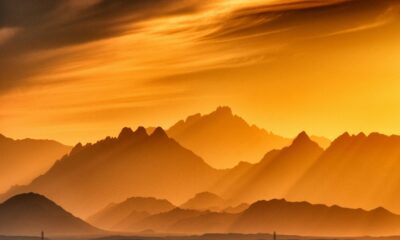
 Nyheter3 veckor sedan
Nyheter3 veckor sedanMahvie Minerals växlar spår – satsar fullt ut på guld
-
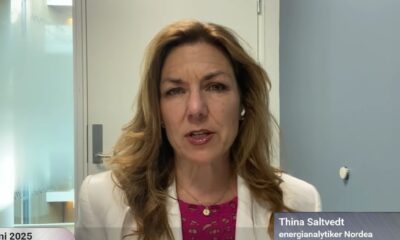
 Nyheter4 veckor sedan
Nyheter4 veckor sedanUppgången i oljepriset planade ut under helgen
-

 Nyheter4 veckor sedan
Nyheter4 veckor sedanLåga elpriser i sommar – men mellersta Sverige får en ökning
-

 Analys3 veckor sedan
Analys3 veckor sedanA muted price reaction. Market looks relaxed, but it is still on edge waiting for what Iran will do
-

 Nyheter3 veckor sedan
Nyheter3 veckor sedanJonas Lindvall är tillbaka med ett nytt oljebolag, Perthro, som ska börsnoteras
-

 Nyheter3 veckor sedan
Nyheter3 veckor sedanOljan, guldet och marknadens oroande tystnad
-

 Analys4 veckor sedan
Analys4 veckor sedanVery relaxed at USD 75/b. Risk barometer will likely fluctuate to higher levels with Brent into the 80ies or higher coming 2-3 weeks
-

 Nyheter3 veckor sedan
Nyheter3 veckor sedanDomstolen ger klartecken till Lappland Guldprospektering






